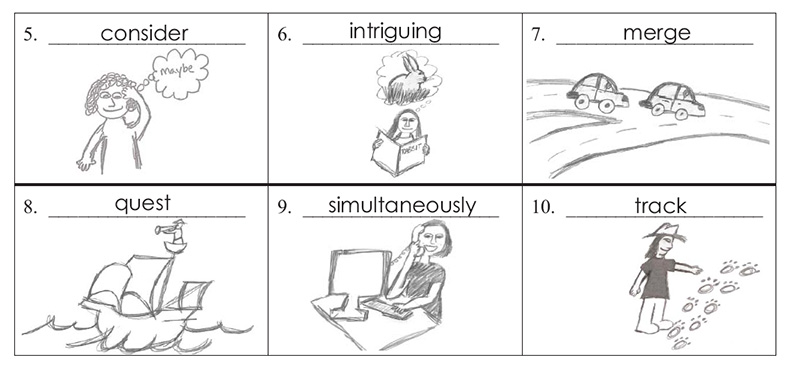Supplemental Activities
Sketching vocabulary words: valuable word-learning strategy
32640 Views
As you know, vocabulary is a key component for success in reading. There are many benefits to having a large vocabulary, but none is more valuable than the positive contribution that vocabulary size makes to reading comprehension (Nagy, 2005).
So how many vocabulary words should you aim to teach your students per year? It is estimated that there are about 88,500 distinct word families in printed school English, and the average twelfth grader probably knows about 40,000 of them (Nagy and Anderson, 1984). Our students need to learn tens of thousands of new words—way more than you have time to explicitly teach.
Fortunately, explicit word teaching is not the only way to expand vocabulary. It is essential to teach word-learning strategies as well. Combined with the instruction of high-utility words, word-learning strategies increase vocabulary and allow students to become independent word learners (Bauman, Kame'enui, and Ash, 2003; Beck et al., 1982). Students need a wide range of word-learning strategies that engage them in actively thinking about word meanings, the relationships between words, and how words are used in different situations.
Sketching vocabulary words is one such strategy. For many students, it is easier to remember a word’s meaning in a specific context by making a quick sketch that connects the word to something personally meaningful to the student. To employ this strategy, instruct a student to sketch his or her understanding of a new word you are explicitly teaching. The student should not spend much time making a detailed drawing—the sketch simply needs to make sense and help the student remember the meaning. To confirm understanding, the student should be able to describe the sketch and explain how it illustrates the word’s meaning.
Below are sketches one student made for the six target vocabulary words from the story “Bloop” in Read Naturally’s Take Aim at Vocabulary program. Look at each sketch to see if it makes sense to you. Can you see how these sketches would prompt the student to connect with the meaning of each word?

Try this strategy with your students as you are teaching vocabulary words from your current content. Once students are comfortable with this strategy, encourage them to use it to remember the meanings of new words they encounter in the future. To work totally independently, they may use this strategy in conjunction with a dictionary or glossary.
Save time by providing a template with a small space for each sketch, so students can be encouraged to make quick (rather than elaborate) sketches. The free template listed below under "Resources" has spaces for sketching six target words.
Resources
 Free template for vocabulary word sketches
Free template for vocabulary word sketches
 Printable samples of the Take Aim at Vocabulary program
Printable samples of the Take Aim at Vocabulary program
Bibliography
Baumann, J. F., Edwards, E. C., Boland, E., Olejnik, S., & Kame'enui, E. (2003). “Vocabulary tricks: effects of instruction in morphology and context on fifth grade students’ ability to derive and infer word meanings,” American Educational Research Journal, Vol. 40, No. 2, pp. 447–494.
Beck, I. L., Perfetti, C., & McKeown, M. G. (1982). “Effects of long term vocabulary instruction on lexical access and reading comprehension,” Journal of Educational Psychology, Vol. 74, No. 4, pp. 506–521.
Graves, M. F. (2000). “A vocabulary program to complement and bolster a middle-grade comprehension program,” in B. M. Taylor, M. F. Graves, and P. Van Den Broek (eds.), Reading for meaning: Fostering comprehension in the middle grades, New York: Teachers College Press.
Nagy, W. E. (2005). “Why vocabulary instruction needs to be long-term and comprehensive,” in E. H. Hiebert and M. L. Kamil (eds.), Teaching and learning vocabulary: Bringing research to practice, Mahwah, NJ: Erlbaum.
Nagy, W. E. & Anderson, R. C. (1984). “How many words are there in printed school English?” Reading Research Quarterly, Vol. 19, pp. 304-330.
Please let us know what questions you have so we can assist. For Technical Support, please call us or submit a software support request.